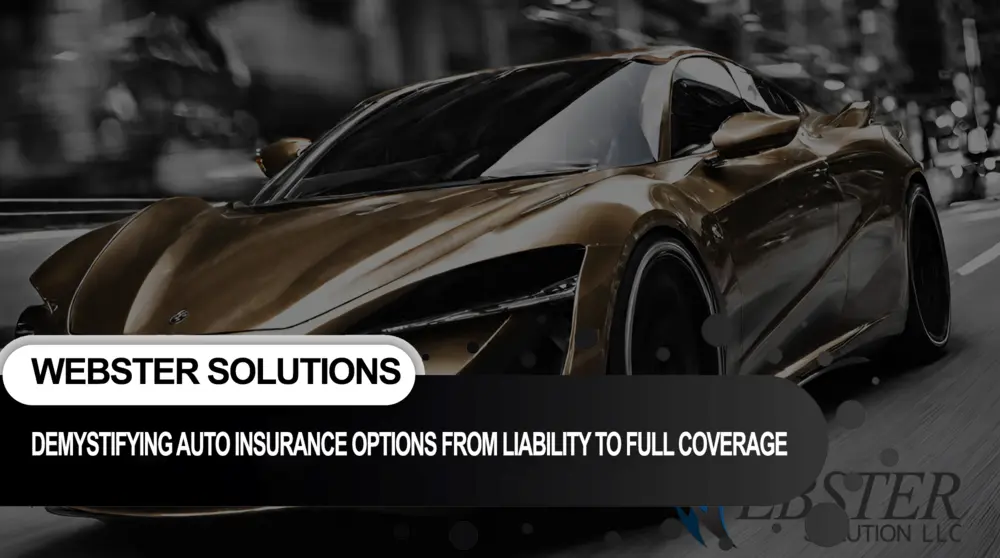Demystifying Auto Insurance Options: From Liability to Full Coverage

Auto insurance is a necessity for every driver, but navigating the labyrinth of coverage options can be overwhelming. From the basic legal requirement of liability insurance to the comprehensive protection of full coverage, understanding your options is essential for making informed decisions about your coverage. Webster Solution will unravel the complexities of auto insurance, guiding you through the journey from liability to full coverage.
🌟 Elevate Your Design 🌟
Representatives are the front-line customer service and support for a company. They are the first people to interact with customers who call in, and their job is to help customers with their inquiries and problems.
- Custom Designs
- Branding Consulting
- Customer Service Representative
Ready to bring your vision to life? Contact our Experts today!
24/7 Customer Support
+1-206-536-2356
Liability Insurance
Liability insurance is the foundational level of coverage that every driver must have. It covers the costs associated with injuries or property damage you may cause to others in an accident where you are at fault. While it’s the minimum legal requirement, it might not be sufficient to protect you from all potential expenses.
Collision Coverage
Collision coverage steps in to cover the repair costs for your vehicle in the event of a collision, regardless of who is at fault. If you have a newer or more valuable car, collision coverage becomes crucial. It ensures that you’re not left with a hefty repair bill after an accident.
Comprehensive Coverage
Comprehensive coverage takes the protection a step further by covering non-collision incidents. This includes damages from theft, vandalism, natural disasters, and other unforeseen events. While not required by law, comprehensive coverage provides peace of mind and a financial safety net against a broader range of risks.
Personal Injury Protection (PIP) and Medical Payments Coverage
Accidents often result in injuries, leading to substantial medical expenses. Personal Injury Protection (PIP) and Medical Payments coverage cater to these costs, irrespective of fault. PIP is more comprehensive, covering medical bills, lost wages, and related expenses, while Medical Payments coverage focuses specifically on medical costs.
Protecting Yourself: Uninsured/Underinsured Motorist Coverage
Not every driver on the road is adequately insured. Uninsured/Underinsured Motorist Coverage ensures that you’re protected if you’re involved in an accident with a driver who lacks insurance or has insufficient coverage. It covers medical expenses, property damage, and, in some cases, lost wages.
The Holistic Approach: Full Coverage
Full coverage is not a single type of insurance but a combination of liability, collision, comprehensive, and additional coverages like PIP and uninsured/underinsured motorist coverage. While it may come at a higher cost, full coverage provides comprehensive protection, offering peace of mind by addressing a wide range of potential risks on the road.
Tailoring Coverage to Your Needs: Customizing Your Policy
One of the strengths of auto insurance is its flexibility. Many insurance providers allow you to customize your policy to better suit your individual needs. This means you can adjust coverage limits, deductibles, and add-ons to create a policy that aligns perfectly with your lifestyle and financial situation. Take advantage of this flexibility to optimize your coverage without breaking the bank.

The Impact of Deductibles: Balancing Cost and Coverage
Deductibles play a significant role in auto insurance. A deductible is the amount you agree to pay out of pocket before your insurance coverage kicks in. Choosing a higher deductible typically results in lower premiums, but it also means you’ll have a higher upfront cost in the event of a claim. Finding the right balance between your deductible and premium can help you strike a cost-effective yet adequately protective insurance policy.
Regular Policy Reviews: Adapting to Life Changes
Life is dynamic, and so are your insurance needs. Regularly reviewing your policy ensures that it evolves with your lifestyle changes. Whether you’ve moved to a new location, bought a new car, or experienced changes in your family structure, keeping your insurance provider informed allows you to make necessary adjustments to your coverage.

Telematics and Usage-Based Insurance: A Modern Approach to Premiums
Innovations in technology have given rise to telematics, which involves using devices or smartphone apps to monitor your driving behavior. This data can be utilized by insurance companies to offer personalized, usage-based insurance. If you exhibit safe driving habits, such as avoiding abrupt stops or limiting nighttime driving, you may qualify for discounts on your premiums. Embracing these technologies not only saves money but also encourages safer driving practices.
Bundling Your Policies: Multi-Line Discounts
Insurance providers often offer discounts when you bundle multiple policies, such as auto and homeowners insurance, with the same company. This approach, known as multi-line insurance, can result in significant savings. Bundling not only simplifies your insurance management but also enhances your ability to negotiate better rates and coverage options.

🌟 Elevate Your Design 🌟
Representatives are the front-line customer service and support for a company. They are the first people to interact with customers who call in, and their job is to help customers with their inquiries and problems.
- Custom Designs
- Branding Consulting
- Customer Service Representative
Ready to bring your vision to life? Contact our Experts today!
24/7 Customer Support
+1-206-536-2356
Frequently Asked Questions (FAQs)
In most states, liability insurance is the minimum coverage required by law. This type of insurance covers the costs of injuries and property damage that you may cause to others in an accident for which you are at fault.
Full coverage is not a specific type of insurance but a combination of coverages, including liability, collision, comprehensive, personal injury protection (PIP), and uninsured/underinsured motorist coverage. It provides more comprehensive protection than just liability insurance.
Usage-based insurance involves using technology, such as smartphone apps or telematics devices, to monitor driving behaviour. Insurers may offer discounts or rewards based on safe driving habits, such as avoiding sudden stops or limiting nighttime driving.
Yes, many insurance companies offer discounts for good driving behavior. Maintaining a clean driving record, attending defensive driving courses, and installing safety features in your vehicle are common ways to qualify for lower premiums.
Peer-to-peer insurance is a community-based approach where a group of individuals pools resources to create a self-insured community. Members share risks and contribute to a common fund, fostering a sense of trust and community within the group.








